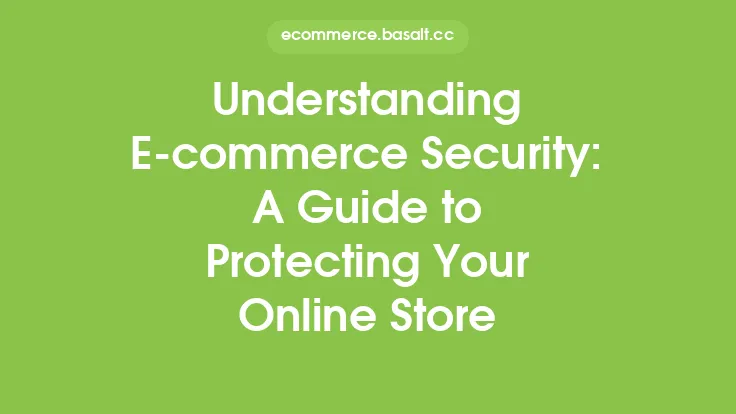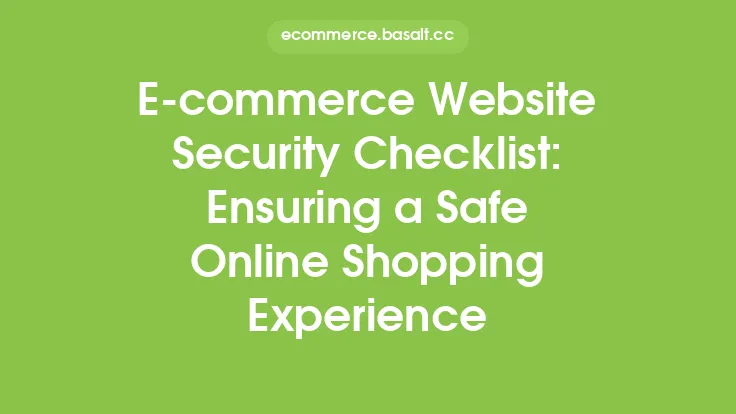As the world of e-commerce continues to grow and evolve, the importance of security cannot be overstated. With more and more consumers turning to online shopping, the potential for cyber threats and data breaches has increased exponentially. In order to protect your online store and maintain the trust of your customers, it is essential to have a comprehensive understanding of e-commerce security.
Introduction to E-commerce Security
E-commerce security refers to the measures and protocols put in place to protect online stores from cyber threats, data breaches, and other forms of malicious activity. This includes everything from securing payment gateways and protecting customer data to preventing hacking and other forms of cyber attacks. Effective e-commerce security is critical for building trust with customers, protecting sensitive information, and maintaining the integrity of online transactions.
The Importance of E-commerce Security
The importance of e-commerce security cannot be overstated. A single data breach or cyber attack can have devastating consequences for an online store, including financial losses, damage to reputation, and legal repercussions. Furthermore, with the rise of online shopping, consumers are becoming increasingly aware of the importance of security and are more likely to choose online stores that prioritize their safety and protection. By investing in e-commerce security, online store owners can protect their customers, maintain their reputation, and ensure the long-term success of their business.
Key Components of E-commerce Security
There are several key components of e-commerce security that online store owners should be aware of. These include:
- Secure payment gateways: This refers to the use of secure protocols such as HTTPS and TLS to protect payment information and prevent interception by third parties.
- Data encryption: This involves the use of encryption algorithms to protect sensitive customer data, such as credit card numbers and personal identifiable information.
- Firewalls and intrusion detection systems: These are used to prevent unauthorized access to the online store and detect potential security threats.
- Secure passwords and authentication: This involves the use of strong passwords, two-factor authentication, and other measures to prevent unauthorized access to customer accounts and administrative panels.
- Regular security updates and patches: This involves regularly updating software and plugins to prevent exploitation of known vulnerabilities.
E-commerce Security Standards and Compliance
There are several e-commerce security standards and compliance regulations that online store owners should be aware of. These include:
- Payment Card Industry Data Security Standard (PCI DSS): This is a set of security standards designed to ensure that online stores that accept credit card payments are protecting sensitive customer information.
- General Data Protection Regulation (GDPR): This is a European Union regulation that governs the collection, storage, and use of personal data.
- California Consumer Privacy Act (CCPA): This is a California state regulation that governs the collection, storage, and use of personal data.
- Secure Sockets Layer/Transport Layer Security (SSL/TLS): This is a security protocol used to encrypt data transmitted between the online store and the customer's browser.
Best Practices for Implementing E-commerce Security
There are several best practices that online store owners can follow to implement effective e-commerce security. These include:
- Conducting regular security audits and risk assessments to identify potential vulnerabilities.
- Implementing a web application firewall (WAF) to protect against common web attacks.
- Using secure protocols such as HTTPS and TLS to encrypt data transmitted between the online store and the customer's browser.
- Implementing two-factor authentication to prevent unauthorized access to customer accounts and administrative panels.
- Regularly updating software and plugins to prevent exploitation of known vulnerabilities.
- Providing security awareness training to employees and stakeholders to prevent social engineering attacks.
Conclusion
In conclusion, e-commerce security is a critical component of online store ownership. By understanding the key components of e-commerce security, following best practices, and complying with relevant security standards and regulations, online store owners can protect their customers, maintain their reputation, and ensure the long-term success of their business. As the world of e-commerce continues to evolve, it is essential to stay informed about the latest security threats and best practices to ensure the safety and protection of online stores and their customers.




